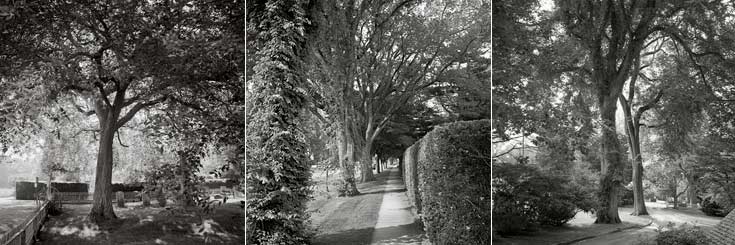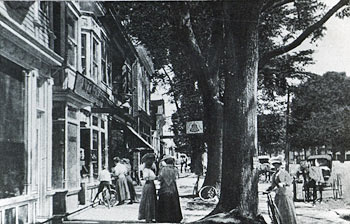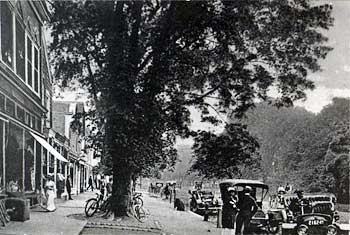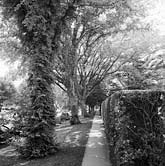

Photographs © Garie Waltzer
Founded in 1648, the village of East Hampton features one of the nation's finest small architectural and landscape ensembles. By 1895, its American elms (Ulmus americana) were noted in print; later, Childe Hassam made them famous by including them in his 1920 painting of the village. While the elms could have been decimated by Dutch elm disease, the Ladies Village Improvement Society has worked for the past century to make sure that these specimens continue to form a high, leafy canopy over the streets of the small historic village.
History


2. Main Street circa 1890. Images Courtesy East Hampton Library,
C.F. Dayton Photo Collection
In the mid-19th century, books such as The American Woman's Home (1869) by Catharine Ward Beecher and her more famous sister, Harriet Beecher Stowe, became popular among women readers who welcomed the nascent American park movement. Intending to improve the situation for city dwellers, supporters of the park movement extolled the importance of aesthetically pleasing green spaces that would act as “lungs” within crowded cities and towns. The first great American public park was Central Park in New York designed in 1858 by two men, Frederick Law Olmsted, Sr., and Calvert Vaux. Until the 20th century, women had no professional opportunities to become park-makers themselves. Instead, by working together on a multitude of small civic projects including street tree programs, they gained experience and confidence that eventually gained them access to the country’s schools of landscape architecture.
In 1895, in the Village of East Hampton, a group of 21 women formed the Ladies Village Improvement Society (LVIS). The group was established to improve civic beauty, which, by 1907, included care of the village’s stately American elms (Ulmus americana). .Such elms once shaded the streets of cities, towns, and villages from the northern reaches of New England down through the Middle States, and throughout the Midwest. Chosen because of its arching form and rapid growth, the elm became the quintessential street tree. East Hampton’s elms were used in publicizing the town.
In 1938, East Hampton’s elms faced their first major threat. A fast moving hurricane decimated more than a third of the older elms and subsequent flooding damaged many of the recent plantings. The LVIS partnered with the village leaders by contributing a large share of the cost of replacing trees felled by the hurricane.
Courtesy Ladies Village Improvement Society
The threat to the trees was not over, however. By 1930 the fungus Ceratocystis ulmi, a wilt carried by bark beetles, had already arrived in the United States via a shipment of logs imported from Europe. Termed “Dutch Elm Disease” because scientists in the Netherlands were the first to identify the source of the disease, the fungus spread between the roots of closely-planted elms trees across the country, devastating streets and neighborhoods and destroying the tree canopies of entire cities. By 1970, the disease was blamed for the death of nearly 80 million elms in the United States. In 1978, East Hampton lost 69 elms along its streets and thirteen more on private property. The Village of East Hampton and the LVIS jointly took responsibility not just for the elms, but also for the health of 3,500 trees on streets and village property. Together, they developed a comprehensive database and hired a fulltime arborist as well as plant pathology experts who visit annually. The public works department and LVIS Tree Program members monitor and trim all trees and protect their expanding root systems from sidewalks and street curbs, keeping them free from stress.
One of the largest elms in East Hampton is located on the LVIS headquarters property and has a 14-foot circumference at breast height. All of the trees are tested for disease and inspected regularly. In order to avoid the dangers presented by a monoculture, replacement trees are not always elms, but they are always of a significant size. This diligence and the strong partnership between LVIS and the Village has led to one of the most successful street tree programs in the nation.
Today, nearly 200 American elms still contribute to the high leafy canopy over the streets of the village of East Hampton. The trees’ significance can found in their beauty, age, surprising survival, and the educational opportunities they offer about caring for an endangered species; however, many also are historical monuments—“witness trees” to the beginnings of America's public park and city beautification movements.
Threat
While the LVIS continues to monitor the trees, East Hampton Mayor Paul Rickenbach recently (2009) became concerned that the village’s elms could be threatened by a group of dying elms in Southold, a few short miles across the Peconic Bay. Suffolk County says that it is monitoring the Southold trees, but diligence is essential to preventing any spread of the fungus.


